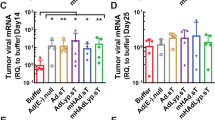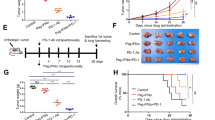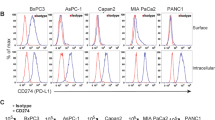Abstract
The objective of the study was to evaluate the utility of NV1042, a replication competent, oncolytic herpes simplex virus (HSV) containing the interleukin-12 (IL-12) gene, as primary treatment for hepatic tumors and to further assess its ability to reduce tumor recurrence following resection. Resection is the most effective therapy for hepatic malignancies, but is not possible in the majority of the patients. Furthermore, recurrence is common after resection, most often in the remnant liver and likely because of microscopic residual disease in the setting of postoperative host cellular immune dysfunction. We hypothesize that, unlike other gene transfer approaches, direct injection of liver tumors with replication competent, oncolytic HSV expressing IL-12 will not only provide effective control of the parent tumor, but will also elicit an immune response directed at residual tumor cells, thus decreasing the risk of cancer recurrence after resection. Solitary Morris hepatomas, established in Buffalo rat livers, were injected directly with 107 particles of NV1042, NV1023, an oncolytic HSV identical to NV1042 but without the IL-12 gene, or with saline. Following tumor injection, the parent tumors were resected and measured and the animals were challenged with an intraportal injection of 105 tumor cells, recreating the clinical scenario of residual microscopic cancer. In vitro cytotoxicity against Morris hepatoma cells was similar for both viruses at a multiplicity of infection of 1 (MOI, ratio of viral particles to target cells), with >90% tumor cell kill by day 6. NV1042 induced high-level expression of IL-12 in vitro, peaking after 4 days in culture. Furthermore, a single intratumoral injection of NV1042, but not NV1023, induced marked IL-12 and interferon-γ (IFN-γ) expression. Both viruses induced a significant local immune response as evidenced by an increase in the number of intratumoral CD4(+) and CD8(+) lymphocytes, although the peak of CD8(+) infiltration was later with NV1042 compared with NV1023. NV1042 and NV1023 reduced parent tumor volume by 74% (P<.003) and 52% (P<.03), respectively, compared to control animals. Treatment of established tumors with NV1042, but not with NV1023, significantly reduced the number of hepatic tumors after resection of the parent tumor and rechallenge (16.8±11 (median=4) vs. 65.9±15 (median=66) in control animals, P<.025). In conclusion, oncolytic HSV therapy combined with local immune stimulation with IL-12 offers effective control of parent hepatic tumors and also protects against microscopic residual disease after resection. The ease of use of this combined modality approach, which appears to be superior to either approach alone, suggests that it may have clinical relevance, both as primary treatment for patients with unresectable tumors and also as a neoadjuvant strategy for reducing recurrence after resection.
This is a preview of subscription content, access via your institution
Access options
Subscribe to this journal
Receive 12 print issues and online access
$259.00 per year
only $21.58 per issue
Buy this article
- Purchase on Springer Link
- Instant access to full article PDF
Prices may be subject to local taxes which are calculated during checkout





Similar content being viewed by others
References
Fan ST, Lo CM, Liu CL, et al. Hepatectomy for hepatocellular carcinoma: toward zero hospital deaths. Ann Surg. 1999;229:322–330.
Fong Y, Fortner JG, Sun R, et al. Clinical score for predicting recurrence after hepatic resection for metastatic colorectal cancer: analysis of 1001 consecutive cases. Ann Surg. 1999;230:309–321.
Fong Y, Sun RL, Jarnagin W, et al. An analysis of 412 cases of hepatocellular carcinoma at a Western center. Ann Surg. 1999;229:790–799.
Nordlinger B, Vaillant JC, Guiguet M, et al. Survival benefit of repeat liver resections for recurrent colorectal metastases: 143 cases. J Clin Oncol. 1994;12:1491–1496.
Scheele J, Stang R, Altendorf-Hofmann A, et al. Resection of colorectal liver metastases. World J Surg. 1995;19:59–71.
Fan ST . Problems of hepatectomy in cirrhosis. Hepato–Gastro 1998;45(Suppl 3):1288–1290.
Karpoff HM, Tung C, Ng B, et al. Interferon gamma protects against hepatic tumor growth in rats by increasing kupffer cell tumoricidal activity. Hepatology 1996;24:374–379.
Kemeny N, Huang Y, Cohen AM, et al. Hepatic arterial infusion of chemotherapy after resection of hepatic metastases from colorectal cancer. N Eng J Med. 1999;341:2039–2048.
Kemeny N, Gonen M, Sullivan D, et al. Phase I study of hepatic arterial infusion of floxuridine and dexamethasone with systemic irinotecan for unresectable hepatic metastases from colorectal cancer. J Clin Oncol. 2001;19:2687–2695.
Fidler IJ . Systemic macrophage activation with liposome-entrapped immunomodulators for therapy of cancer metastasis. Res Immunol. 1996;143:199–204.
Kawata A, Une Y, Hosokawa M, et al. Adjuvant chemoimmunotherapy for hepatocellular carcinoma patients. Adriamycin, interleukin-2, and lymphokine-activated killer cells versus adriamycin alone. Am J Clin Oncol. 1995;18:257–262.
Connor J, Bannerji R, Saito S, et al. Regression of bladder tumors in mice treated with interleukin-2 gene-modified tumor cells. J Exp Med. 1993;177:1127–1134.
Allione A, Consalvo M, Nanni P, et al. Immunizing and curative potential of replicating and nonreplicating murine mammary adenocarcinoma cells engineered with interleukin (IL)-2, IL-4, IL-6, IL-7, IL-10, tumor necrosis factor alpha, granulocyte-macrophage colony stimulating factor, and gamma-interferon gene or admixed with conventional adjuvants. Cancer Res. 1994;54:6022–6026.
Saito S, Bannerji R, Gansbacher B et al. Immunotherapy of bladder cancer with cytokine gene-modified tumor vaccines. Cancer Res. 1994;54:3516–3520.
Porgador A, Tzehoval E, Vadai E, et al. Immunotherapy via gene therapy: comparison of the effects of tumor cells transduced with the interleukin-2, interleukin-6, or interferon-lambda genes. J Immunother. 1993;14:191–201.
Vieweg J, Rosenthal FM, Bannerji R, et al. Immunotherapy of prostate cancer in the dunning rat model: use of cytokine gene modified tumor vaccines. Cancer Res 1994;54:1760–1765.
Golumbek PT, Lazenby AJ, Levitsky HI, et al. Treatment of established renal cancer by tumor cells engineered to secrete interleukin-4. Science 1991;254:713–716.
Porgador A, Tzehoval E, Katz A, et al. Interleukin 6 gene transfection into Lewis lung carcinoma tumor cells suppresses the malignant phenotype and confers immunotherapeutic competence against parental metastatic cells. Cancer Res. 1992;52:3679–3686.
Dranoff G, Jaffee E, Lazenby A, et al. Vaccination with irradiated tumor cells engineered to secrete murine granulocyte-macrophage colony-stimulating factor stimulates potent, specific, and long-lasting anti-tumor immunity. Proc Natl Acad Sci USA. 1993;90:3539–3543.
D'Angelica M, Tumg C, Alien P, et al. HSV-mediated ICAM-1 gene transfer abrogates tumorigenicity and induces anti-tumor immunity. Mol Med. 1999;5:606–616.
Colombo MP, Ferrari G, Stoppacciaro A, et al. Granulocyte colony-stimulating factor gene transfer suppresses tumorigenicity of a murine adenocarcinoma in vivo. J Exp Med. 1991;173:889–897.
Gansbacher B, Zier K, Daniels B, et al. Interleukin-2 gene transfer into tumor cells abrogates tumorigenicity and induces protective immunity. J Exp Med. 1990;172:1217–1224.
Jarnagin WR, Delman K, Kooby D, et al. Neoadjuvant interluekin-12 immunogene therapy protects against cancer recurrence after liver resection in an animal model. Ann Surg. 2000;231:762–771.
Kooby DA, Carew JF, Halterman MW, et al. Oncolytic viral therapy for human colorectal cancer and liver metastases using a multimutated herpes simplex virus type-1 (G207). FASEB J. 1999;15:1306–1308.
Mineta T, Rabkin SD, Yazaki T, et al. Attenuated multi-mutated herpes simplex virus-1 for the treatment of malignant gliomas. Nat Med. 1995;1:938–943.
Pyles RB, Thompson RL . Evidence that the herpes simplex virus type 1 uracil DNA glycosylace is required for efficient viral replication and latency in the murine nervous system. J Virol. 2002;68:4963–4972.
Bennett JJ, Kooby D, Delman K, et al. Antitumor efficacy of regional oncolytic viral therapy for peritoneally disseminated cancer. J Mol Med. 2002;78:166–174.
Carew JF, Kooby D, Halterman MW, et al. Selective infection and cytolysis of human head and neck squamous cell carcinoma with sparing of normal mucosa by a cytolytic herpes simplex virus type 1 (G207). Human Gene Therapy. 1999;10:1599–1606.
Karpoff HM, D'Angelica M, Blair S, et al. Prevention of hepatic tumor metastases in rats with herpes viral vaccines and gamma-interferon. J Clin Invest. 1997;99:799–804.
Tahara H, Zeh, III HJ, Storkus WJ, et al. Fibroblasts genetically engineered to secrete interleukin 12 can suppress tumor growth and induce antitumor immunity to a murine melanoma in vivo. Cancer Res. 1994;54:182–189.
Rao JB, Chamberlain RS, Bronte V, et al. IL-12 is an effective adjuvant to recombinant vaccinia virus-based tumor vaccines: enhancement by simultaneous B7-1 expression. J Immunol. 1996;156:3357–3365.
Federoff HJ . Replication-defective herpesvirus amplicon vectors and their use for gene transfer. In: Spector DL, Leinwand L, Goldman R, eds. Cells. A Laboratory Manual. Plainview, NY: Cold Spring Harbor Laboratory Press, 1998:19.1–91.10.
Bennett JJ, Malhotra S, Wong RJ, et al. Interleukin 12 secretion enhances antitumor efficacy of oncolytic herpes simplex viral therapy for colorectal cancer. Ann Surg 2002;233:819–826.
Brunda MJ, Luistro L, Warrier RR, et al. Antitumor and antimetastatic activity of interleukin 12 against murine tumors. J Exp Med. 1993;178:1223–1230.
Vagliani M, Rodolfo M, Cavallo F, et al. Interleukin 12 potentiates the curative effect of a vaccine based on Interleukin 2-transduced tumor cells. Cancer Res. 1996;56:467–470.
Meignier B, Longnecker R, Roizman B . In vivo behavior of genetically engineered herpes simplex viruses R7017 and R7020: construction and evaluation in rodents. J Inf Dis. 1988;158:602–614.
Meignier B, Martin B, Whitley RJ, et al. In vivo behavior of genetically engineered herpes simplex viruses R7017 and R7020. II. Studies in immunocompetent and immunosuppressed owl monkeys (Aotus trivirgatus). J Inf Dis. 1990;162:313–321.
Wong RJ, Patel SG, Kirn S, et al. Cytokine gene transfer enhances herpes oncolytic therapy in murine squamous cell carcinoma. Hum Gene Ther. 2001;12:253–265.
Sung MW, Yeh HC, Thung SN, et al. Intratumoral adenovirus-mediated suicide gene transfer for hepatic metastases from colorectal adenocarcinoma: results of a phase I clinical trial. Mol Ther: J Am Soc Gene Ther. 2001;4:182–191.
Habib N, Salama H, Abd El Latif Abu Median, et al. Clinical trial of EIB-deleted adenovirus (dl1520) gene therapy for hepatocellular carcinoma. Cancer Gene Ther. 2002;9:254–259.
Reid T, Galanis E, Abbruzzese J, et al. Intra-arterial administration of a replication-selective adenovirus (dl1520) in patients with colorectal carcinoma metastatic to the liver: a phase I trial. Gene Therapy. 2001;8:1618–1626.
Breakefield XO, DeLuca NA . Herpes simplex virus for gene delivery to neurons. New Biol. 1991;3:203–218.
D'Angelica M, Karpoff H, Brownlee M, et al. In vivo IL-2 gene transduction of implanted tumors induces a systemic anti-tumor response. Cancer, Immunology and Immunotherpay. 1999;47 (5):265–271.
Author information
Authors and Affiliations
Corresponding author
Additional information
Supported in part by training Grant T32 CA 09501 (ME) and US Public Health Service grants RO1CA75416, RO1CA72632, and RO1CA61524 from the National Institutes of Health and MBC-99366 from the American Cancer Society (YF).
Rights and permissions
About this article
Cite this article
Jarnagin, W., Zager, J., Klimstra, D. et al. Neoadjuvant treatment of hepatic malignancy: an oncolytic herpes simplex virus expressing IL-12 effectively treats the parent tumor and protects against recurrence-after resection. Cancer Gene Ther 10, 215–223 (2003). https://doi.org/10.1038/sj.cgt.7700558
Received:
Published:
Issue Date:
DOI: https://doi.org/10.1038/sj.cgt.7700558
Keywords
This article is cited by
-
Personalizing Oncolytic Immunovirotherapy Approaches
Molecular Diagnosis & Therapy (2024)
-
Safety and antitumor effect of oncolytic and helper-dependent adenoviruses expressing interleukin-12 variants in a hamster pancreatic cancer model
Gene Therapy (2015)
-
Molecular network pathways and functional analysis of tumor signatures associated with development of resistance to viral gene therapy
Cancer Gene Therapy (2012)
-
Oncolytic HSV and Erlotinib Inhibit Tumor Growth and Angiogenesis in a Novel Malignant Peripheral Nerve Sheath Tumor Xenograft Model
Molecular Therapy (2007)
-
Enhanced therapeutic efficacy of IL-12, but not GM-CSF, expressing oncolytic herpes simplex virus for transgenic mouse derived prostate cancers
Cancer Gene Therapy (2006)



